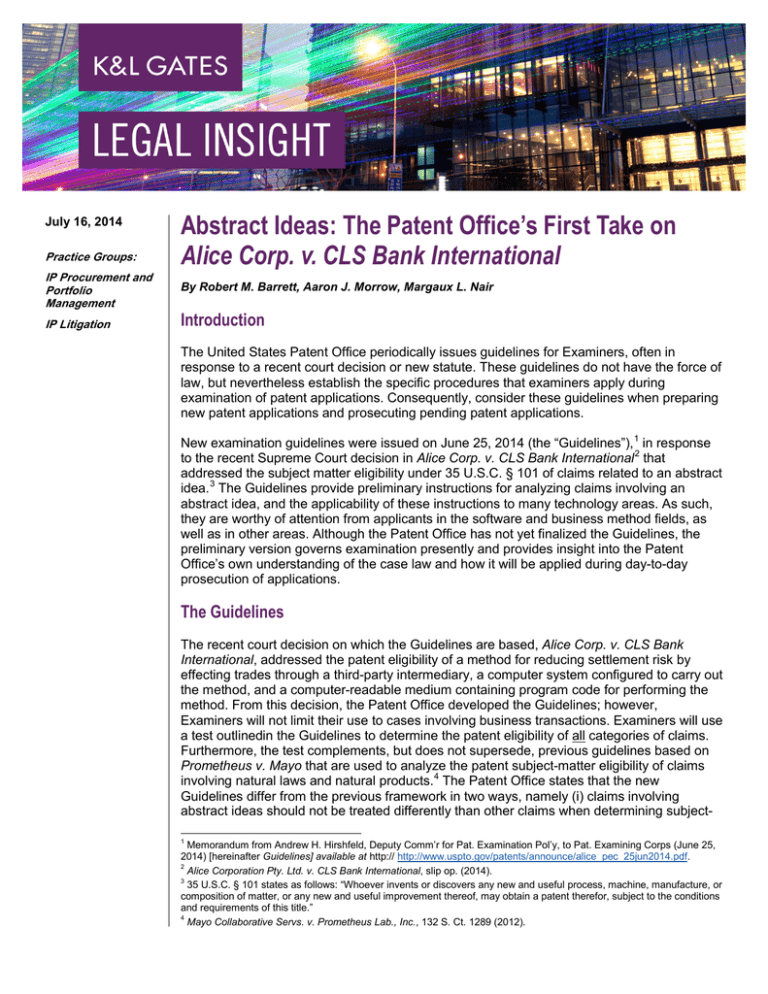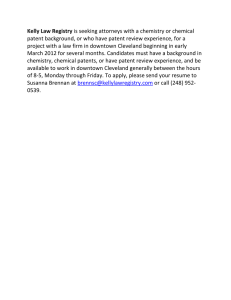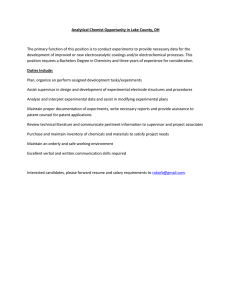
July 16, 2014
Practice Groups:
IP Procurement and
Portfolio
Management
IP Litigation
Abstract Ideas: The Patent Office’s First Take on
Alice Corp. v. CLS Bank International
By Robert M. Barrett, Aaron J. Morrow, Margaux L. Nair
Introduction
The United States Patent Office periodically issues guidelines for Examiners, often in
response to a recent court decision or new statute. These guidelines do not have the force of
law, but nevertheless establish the specific procedures that examiners apply during
examination of patent applications. Consequently, consider these guidelines when preparing
new patent applications and prosecuting pending patent applications.
New examination guidelines were issued on June 25, 2014 (the “Guidelines”), 1 in response
to the recent Supreme Court decision in Alice Corp. v. CLS Bank International 2 that
addressed the subject matter eligibility under 35 U.S.C. § 101 of claims related to an abstract
idea. 3 The Guidelines provide preliminary instructions for analyzing claims involving an
abstract idea, and the applicability of these instructions to many technology areas. As such,
they are worthy of attention from applicants in the software and business method fields, as
well as in other areas. Although the Patent Office has not yet finalized the Guidelines, the
preliminary version governs examination presently and provides insight into the Patent
Office’s own understanding of the case law and how it will be applied during day-to-day
prosecution of applications.
The Guidelines
The recent court decision on which the Guidelines are based, Alice Corp. v. CLS Bank
International, addressed the patent eligibility of a method for reducing settlement risk by
effecting trades through a third-party intermediary, a computer system configured to carry out
the method, and a computer-readable medium containing program code for performing the
method. From this decision, the Patent Office developed the Guidelines; however,
Examiners will not limit their use to cases involving business transactions. Examiners will use
a test outlinedin the Guidelines to determine the patent eligibility of all categories of claims.
Furthermore, the test complements, but does not supersede, previous guidelines based on
Prometheus v. Mayo that are used to analyze the patent subject-matter eligibility of claims
involving natural laws and natural products.4 The Patent Office states that the new
Guidelines differ from the previous framework in two ways, namely (i) claims involving
abstract ideas should not be treated differently than other claims when determining subject1
Memorandum from Andrew H. Hirshfeld, Deputy Comm’r for Pat. Examination Pol’y, to Pat. Examining Corps (June 25,
2014) [hereinafter Guidelines] available at http:// http://www.uspto.gov/patents/announce/alice_pec_25jun2014.pdf.
2
Alice Corporation Pty. Ltd. v. CLS Bank International, slip op. (2014).
3
35 U.S.C. § 101 states as follows: “Whoever invents or discovers any new and useful process, machine, manufacture, or
composition of matter, or any new and useful improvement thereof, may obtain a patent therefor, subject to the conditions
and requirements of this title.”
4
Mayo Collaborative Servs. v. Prometheus Lab., Inc., 132 S. Ct. 1289 (2012).
Abstract Ideas: The Patent Office’s First Take on
Alice Corp. v. CLS Bank International
matter eligibility and (ii) the same analysis should be used for all categories of claims,
instead of treating product claims and process claims differently.
The test outlined in the Guidelines includes two steps: (i) determine if the claim is directed to
an abstract idea 5 and (ii) if an abstract idea is present in the claim, determine whether any
element or combination of elements ensures that the claim is directed to significantly more
than the abstract idea itself. 6
Consequences for Patent Practice
With its first step focused on the notion of “an abstract idea”, the test may ultimately be
applied to many technology areas because the Patent Office, like the Supreme Court in the
opinion for CLS Bank v. Alice, does not provide a definition of an abstract idea, leavingthe
meaning of the term and the scope of the test open to interpretation. . However, the Patent
Office does provide a few examples of abstract ideas, including fundamental economic
practices, certain methods of organizing human activity, mathematical relationships and
formulae, and “and idea itself.” 7 While these examples of abstract ideas suggest that
analyzing patent claims to avoid abstraction will continue to be important for inventors with
patent applications directed to software or business methods, there is little guidance as to
the scope ofwhat may constitute an abstract idea. Therefore, anyone with applications
outside these areas should also expect to see rejections under this new test, particularly if
the claim involves application of a technique using a computer.
Building upon the Patent Office’s recent guidelines on natural laws and natural products
based on the teachings of the Prometheus v. Mayo and Myriad8 cases, the new Guidelines
provide a familiar read with respect to whether a claim directed to an abstract idea claims
“significantly more” than the judicial exception to patent-eligible subject matter. Similar to the
previous guidelines for natural products and natural laws, the test based on CLS Bank v.
Alice sets forth factors and characteristics to which Examiners and applicants may analogize
to provide information on precisely when a claim recites “significantly more” than an abstract
idea and, thus, claims patent-eligible subject matter. The test suggests that if the claims
include improvements to another technology or technical field, improvements to the
functioning of a computer (as opposed to mere implementation of an idea using a computer),
or other meaningful limitations beyond linking the idea to a technological environment, then
the claim will likely be directed to patent-eligible subject matter. In contrast, claims that only
apply the abstract idea, implement it using a computer, or require a computer to perform
known and generic functions or conventional activities will likely not be patent-eligible. The
Patent Office is expected to provide additional examples and clarification upon release of
final guidelines.
5
Guidelines at 2-3.
Id. at 3.
7
Id. at 2–3.
8
Ass’n for Molecular Pathology v. Myriad Genetics, Inc., 133 S. Ct. 2107, 2116 (2013)
6
2
Abstract Ideas: The Patent Office’s First Take on
Alice Corp. v. CLS Bank International
Further Clarification from the Patent Office
As the present Guidelines are only preliminary, the Patent Office will come out with final
instructions in due course. Nevertheless, there are some hints as to the form the final
guidelines may take. For example, the previous natural laws and natural products guidelines
currently note that claims that may be directed to abstract ideas should be examined
separately; 9 however, as expressly noted in the memorandum accompanying the present
Guidelines, the Prometheus v. Mayo framework is also applied. 10 In light of this, the Patent
Office will likely provide a series of examples applying factors similar to those in the natural
laws and natural products guidelines. The Patent Office may even provide a new
combination document addressing how claims including any type of judicial exception should
be treated.
At present, the Patent Office is seeking comments and feedback from the public. Based on
analysis of the preliminary guidelines and comment process that led to the final guidelines for
examination of claims directed to natural laws or natural products, the comment process will
likely play a large role in shaping the structure and details of the final guidelines for abstract
ideas. Accordingly, applicants with portfolios including applications that may be interpreted to
include an abstract idea, regardless of the technology area, should strongly consider
submitting comments to the Patent Office regarding the scope and application of the
Guidelines.
Conclusion
Time will tell whether more frequent non-statutory subject matter rejections will result from
the preliminary instructions based on CLS Bank v. Alice. New rejections may also be seen in
areas outside of business methods or software as well. Preventing or overcoming these
rejections may be possible using a forward-thinking approach that includes adding detailed
descriptions of all elements that could be understood to be “significantly more” than just an
abstract idea, such as improvements to another technology or technical field, improvements
to the functioning of the computer itself, or limitations beyond a general link between the
abstract idea and a particular technological environment.
9
Memorandum from Andrew H. Hirshfeld, Deputy Comm’r for Pat. Examination Pol’y, to Pat. Examining Corps at 2
(March 4, 2014) available at http://www.uspto.gov/patents/law/exam/myriad-mayo_guidance.pdf.
10
Guidelines at 2.
3
Abstract Ideas: The Patent Office’s First Take on
Alice Corp. v. CLS Bank International
Authors:
Robert M. Barrett
robert.barrett@klgates.com
+1.312.807.4204
Aaron J. Morrow
aaron.morrow@klgates.com
+1.312.781.6043
Margaux L. Nair
margaux.nair@klgates.com
+1.312.807.4280
Anchorage Austin Beijing Berlin Boston Brisbane Brussels Charleston Charlotte Chicago Dallas Doha Dubai Fort Worth Frankfurt
Harrisburg Hong Kong Houston London Los Angeles Melbourne Miami Milan Moscow Newark New York Orange County Palo Alto Paris
Perth Pittsburgh Portland Raleigh Research Triangle Park San Diego San Francisco São Paulo Seattle Seoul Shanghai Singapore Spokane
Sydney Taipei Tokyo Warsaw Washington, D.C. Wilmington
K&L Gates comprises more than 2,000 lawyers globally who practice in fully integrated offices located on five
continents. The firm represents leading multinational corporations, growth and middle-market companies, capital
markets participants and entrepreneurs in every major industry group as well as public sector entities, educational
institutions, philanthropic organizations and individuals. For more information about K&L Gates or its locations,
practices and registrations, visit www.klgates.com.
This publication is for informational purposes and does not contain or convey legal advice. The information herein should not be used or relied upon in
regard to any particular facts or circumstances without first consulting a lawyer.
© 2014 K&L Gates LLP. All Rights Reserved.
4


